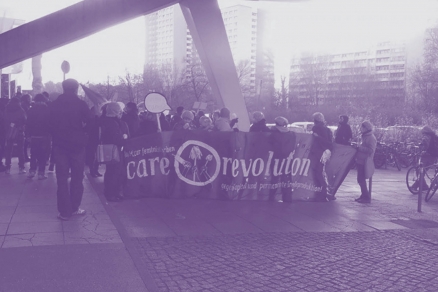
The situation on the left is contradictory: time and again, there are impressive mobilizations by the climate justice movement, Black Lives Matter, Migrantifa, Deutsche Wohnen & Co Enteignen or against the AfD. More young people are influenced by feminist, anti-racist, ecological and other left-wing struggles than we would have hoped a few years ago. At the same time, these movements often remain selective, develop only short-term shifts in discourse and are rarely able to assert their concrete demands. Above all, they are unable to change the lack of strategy and weakness of left-wing and radical left-wing organizations.
The coronavirus pandemic, with its omnipresent risk of infection, lockdowns and restrictions on the right of assembly, has prevented many people from taking the streets in protest and resistance. Like society as a whole, our own structures and those of our allies have suffered under the conditions of social isolation. This has exacerbated the neoliberal isolation of people. At the same time, the coronavirus crisis has exposed deep contradictions in the social and radical left, which have prevented joint positions and effective practical interventions.
Similar helplessness and contradictions were evident in the assessment of the Russian war of aggression against Ukraine and the subsequent inflation and energy crisis. What does an anti-militarist stance look like that remains antagonistic to German and Western militarism without denying or unwillingly supporting aggressive Russian imperialism? With whom do we stand in solidarity and what does this mean, for example, for our position on arms deliveries? How do we reconcile the demands for affordable energy and the need for radical climate protection? The Interventionist Left has argued a lot about these questions and found too few answers.
The division in the Left Party is the result and most severe expression of the contradictions in the social left. Between nationalist and vulgar anti-imperialist provocations and bland reformism, the emancipatory forces in the party found themselves in an increasingly difficult position. With the separation now complete, there may be opportunities for a movement-oriented reset. For the IL, the Left Party has always been an important strategic ally, but never a space for political intervention. Our project is and will remain the independent radical left organization.
Trade unions and associations have opened up to social movements in recent years and for example, sought cooperation with parts of the climate justice movement. Overall, however, they remain in their established, social partnership-oriented paths. They are therefore selective partners for alliances and cooperation but largely fail to act as a driving force for radical change.
In the radical left, two forms of politicization have been particularly popular in recent years. First, power-critical identity politics: The latter deals with the various dimensions of discrimination, above all racism, patriarchy and queer- and trans-hostility. The focus lies on one's own positioning and morally correct individual behavior. As a result, identity politics typically has an instructing character, but creates few collective approaches to overcome oppressive relations.
Second, a large number of "red groups" have emerged, with varying degrees of regional strength. They serve the widespread need for political orientation and ideological clarity. Their dogmatic Marxism-Leninism focuses on the growth of their own organization and a radical habitus. They do not see the diversity of the revolutionary left and movements as an opportunity, but primarily as a problem to be overcome through unification and the correct ideology. Consequently, they often appear as a homogeneous bloc and copy their revolutionary role models of the 1920s in terms of ideology and aesthetics. Their choices of alliances usually remain selective and instrumental.
What identity politics and the red groups have in common is that they offer orientation and supposed clarity for the diffuse challenges of the present. Both tendencies - albeit for different reasons - reject the search for a common ground, which often makes the alliances, that are nevertheless necessary, difficult.
Parallel to these developments within the social left, the competition for attention and political positions is increasingly taking place on social media. A few left-wing publicists and influencers use the virtual battlefield to provide impulses for politicization. They offer opportunities for identification and help marginalized positions gain visibility. At the same time, the fleeting nature, individualism and often abbreviated debates on social media represent limitations for processes of collective change. So far, large parts of the organized left have struggled with platforms because they provide a poor environment for long texts and anonymous groups. We want to rise to this challenge by developing more of our own channels and formats that strike a balance between collective speech and the necessary personalization. In doing so, we will not forget that it is not the virtual space that ultimately decides, but the very real street.
The big questions are on the table: how do we need to reformulate the strategies of the social and radical left in the face of multiple crises? How do we not only identify areas of conflict but also become capable of acting within them? How do we update our tactics and forms of action? What is missing for mobilization successes to also lead to material successes? What are collective forms of organization for the 21st century? In short: How do we build social counter power?
